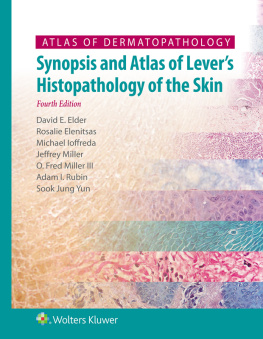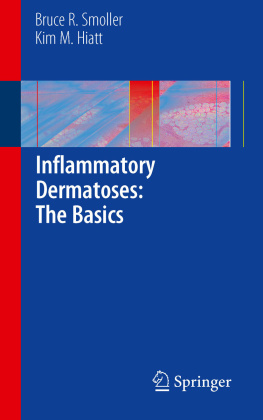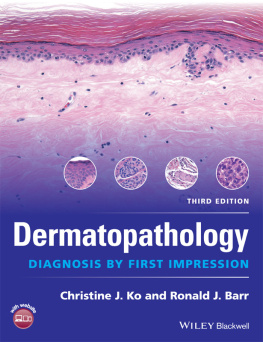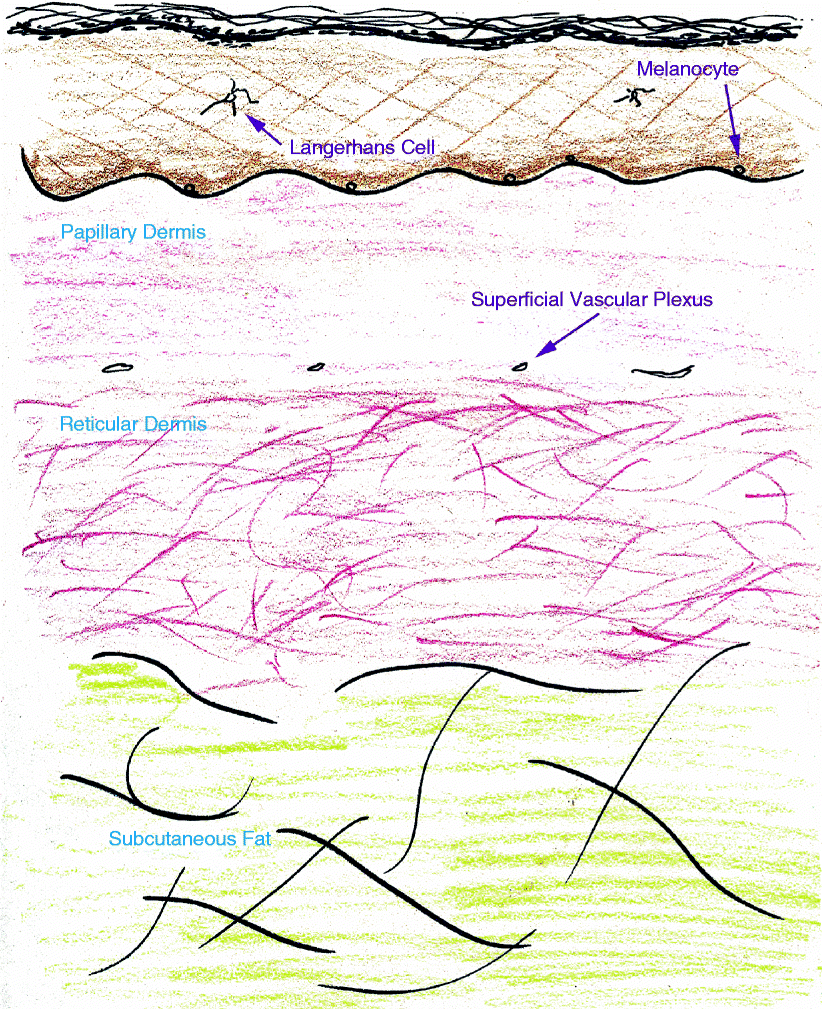Part 1
Anatomy
Kasia S. Masterpol , Andrea Primiani and Lyn M. Duncan Atlas of Essential Dermatopathology 2013 10.1007/978-1-4471-4471-7_1 Springer-Verlag London 2013
1. Basic Anatomy
Kasia Szyfelbein Masterpol 1, Andrea Primiani 2 and Lyn McDivitt Duncan 3
(1)
Department of Dermatology, Boston Medical Center, Boston, MA, USA
(2)
Massachusetts General Hospital WRN2, Pathology Service, Boston, MA, USA
(3)
Massachusetts General Hospital WRN825, Dermatopathology Unit, Boston, MA, USA
Abstract
Stratified squamous epithelium composed of layers of keratinocytes
Epidermis
Stratified squamous epithelium composed of layers of keratinocytes
From superficial to deep:
Stratum corneum
Stratum granulosum
Stratum spinosum
Stratum basale
Intermingled cell types :
Dermis
Papillary dermis :
Dermal papillae complement rete ridges of epidermis
Fine, pale eosinophilic collagen fibers
Contains free nerve endings and Meissners corpuscles
Separated from the reticular dermis by the superficial vascular plexus
Reticular dermis :
Thick, deeply eosinophilic collagen fibers
Contains the deep vascular plexus, adnexal structures, nerve trunks, Pacinian corpuscles, glomus bodies
Fig. 1.1
The skin is composed of epidermis ( brown ), dermis ( pink ) and subcutaneous fat ( yellow ). Dendritic cells in the epidermis include Langerhans cells in the stratum spinosum and melanocytes at the base of the epidermis. The dermis is separated by the superficial vascular plexus into the papillary dermis and reticular dermis
Kasia S. Masterpol , Andrea Primiani and Lyn M. Duncan Atlas of Essential Dermatopathology 2013 10.1007/978-1-4471-4471-7_2 Springer-Verlag London 2013
2. Adnexal Anatomy
Kasia Szyfelbein Masterpol 1, Andrea Primiani 2 and Lyn McDivitt Duncan 3
(1)
Department of Dermatology, Boston Medical Center, Boston, MA, USA
(2)
Massachusetts General Hospital WRN2, Pathology Service, Boston, MA, USA
(3)
Massachusetts General Hospital WRN825, Dermatopathology Unit, Boston, MA, USA
Abstract
The cutaneous adnexal structures include the pilosebaceous apocrine unit and the eccrine unit. Apocrine glands and sebaceous glands secrete their products into the hair follicle through short ducts. The sebaceous glands are often seen in association with hair follicles; apocrine glands are more inconspicuous. The smooth muscle arrector pili connects the pilosebaceous apparatus to the epidermis, contraction of the arrector pili produces goose bumps. The eccrine unit is distinct and separate from the pilosebaceous apocrine unit. The glands lay deep in the dermis, coiled like a garden hose, and are connected to the epidermis by a long straight eccrine duct. The coiled exit of the eccrine duct through the epidermis is termed the acrosyringium
Eccrine Unit
Eccrine Glands : palms, soles, forehead, axillae
Coiled, secretory component in deep dermis
Eccrine Ducts
Long duct, extends from glandular coil in deep dermis to exit through the epidermis as an acrosyringium
Two layers of epithelium, no myoepithelial cells
Pilosebaceous Apocrine Unit
Hair Follicles
Types: terminal (diameter 0.06 mm), vellus (diameter 0.03 mm)
Zones (from superficial to deep):
Infundibulum = region above entry of sebaceous gland duct
Isthmus = extends from attachment of arrector pili muscle to entry of sebaceous gland duct
Hair bulb = dermal papillae and hair matrix
Phases: Anagen (growth), Catagen (involution), Telogen (resting phase)
Hair shaft = composed of cuticle, cortex, and medulla
Arrector pili = smooth muscle innervated by sympathetic nervous system
Sebaceous Glands
Acinar pattern, multiple lobules
Inner layers of cells with vacuolated, lipid-filled cytoplasm
Outer rim of cuboidal basophilic germinative cells
Short duct with stratified squamous epithelium, enters into pilosebaceous unit
Apocrine Units : axillae, anogenital region, areola, eyelid
Fig. 2.1
The cutaneous adnexal structures include the pilosebaceous apocrine unit and the eccrine unit. Apocrine glands and sebaceous glands secrete their products into the hair follicle through short ducts. The sebaceous glands are often seen in association with hair follicles; apocrine glands are more inconspicuous. The smooth muscle arrector pili connects the pilosebaceous apparatus to the epidermis, contraction of the arrector pili produces goose bumps. The eccrine unit is distinct and separate from the pilosebaceous apocrine unit. The glands lay deep in the dermis, coiled like a garden hose, and are connected to the epidermis by a long straight eccrine duct. The coiled exit of the eccrine duct through the epidermis is termed the acrosyringium
Fig. 2.2
Pilosebaceous Apocrine Unit. The sebaceous glands are associated with hair follicles. Apocrine glands are lined by plump epithelial cells with deep pink cytoplasm and surface blebs that are secreted by decapitation ( inset )















